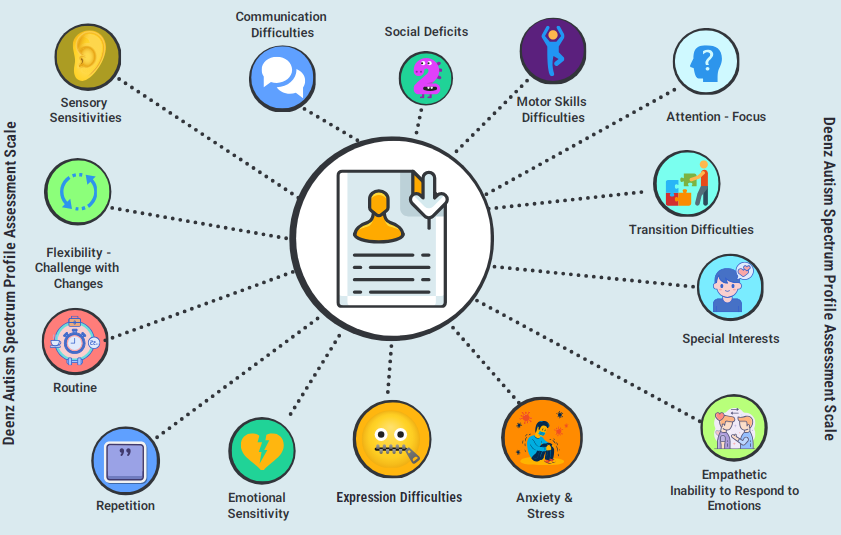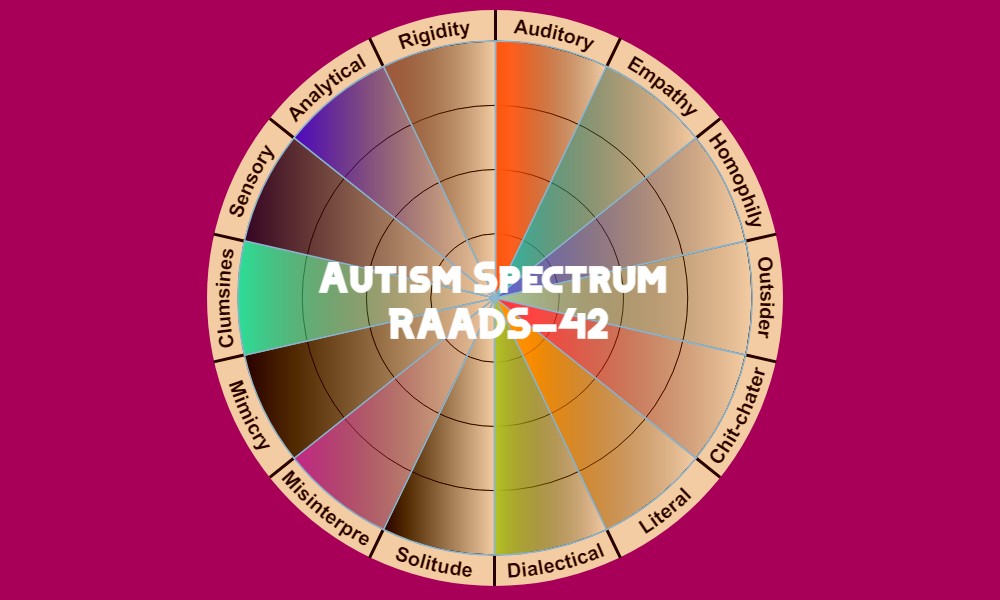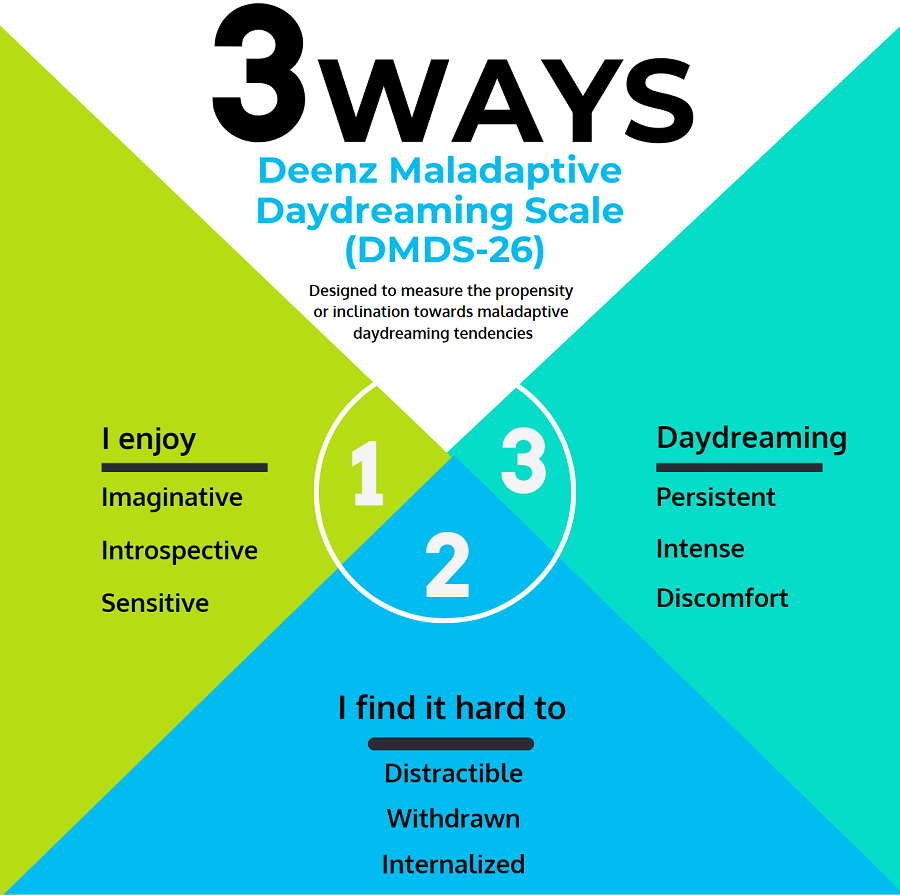Basic information | |
|---|---|
| Statements: | 42 |
| Duration: | 6–8 minutes |
| Rating Scale: | 10-point Likert Scale |
| Type: | Self-assessment |
| Corresponding author: | Deen Mohd Dar |
| Publishing year: | 2024 |
| Seminal Work: | Development and Validity of Deenz Autism Spectrum Profile Assessment Scale (DASPAS-42) [Preprint] |
Deenz Autism Spectrum Profile Assessment Scale is designed to evaluate and assess the profile or pattern of traits, behaviors, and characteristics associated with autism spectrum disorder (ASD). Autism Spectrum Test is a digital adoption of the (DASPAS-42) designed to provide automatic scoring and insights into various aspects of ASD. This instrument is not designed to make a self-diagnosis of autism spectrum disorder. Participation in this test is completely anonymous and NO DATA is collected or stored for research purposes.
Autism spectrum disorder (ASD) is a complex developmental condition- that affects how a person interacts, behaves with others, perceives, and experiences the world around them. ASD is called a spectrum, because it affects people differently- with a specific combination of impairments. [1] Lord, C., Brugha, T. S. — J. L. (2020). Autism spectrum disorder. Nature Reviews Disease Primers, 6(1), 1-23. A person with ASD may find it difficult to communicate and connect with others – may face trouble in expressing feelings, and may find certain sounds, and lights overwhelming.
Deenz Autism Spectrum Profile Assessment Scale adopts a multidimensional approach to assessing challenges and impairment. The main focus of the scale is to examine patterns of traits and behaviors across multiple domains, supported by various research in the field of the autism spectrum. By examining 14 different characteristics associated with Autism Spectrum, the scale provides valuable insights into the unique profiles of individuals.
Autism Spectrum Facets:
References
Lord, C., Brugha, T. S., Charman, T., Cusack, J., Dumas, G., Frazier, T., Jones, E. J., Jones, R. M., Pickles, A., State, M. W., & Taylor, J. L. (2020). Autism spectrum disorder. Nature Reviews Disease Primers, 6(1), 1-23. https://doi.org/10.1038/s41572-019-0138-4 ↩
Frye, R. E. (2018). Social Skills Deficits in Autism Spectrum Disorder: Potential Biological Origins and Progress in Developing Therapeutic Agents. CNS Drugs, 32(8), 713-734. https://doi.org/10.1007/s40263-018-0556-y ↩
Duffy, C., & Healy, O. (2011). Spontaneous communication in autism spectrum disorder: A review of topographies and interventions. Research in Autism Spectrum Disorders, 5(3), 977-983. https://doi.org/10.1016/j.rasd.2010.12.005 ↩
Hazen, Eric P. MD; Stornelli, Jennifer L. MOT, OTR/L; O’Rourke, Julia A. PhD, MS, MMSc; Koesterer, Karmen EdM; McDougle, Christopher J. MD. Sensory Symptoms in Autism Spectrum Disorders. Harvard Review of Psychiatry 22(2):p 112-124, March/April 2014. | DOI: 10.1097/01.HRP.0000445143.08773.58 ↩
Hazen, Eric P. MD; Stornelli, Jennifer L. MOT, OTR/L; O’Rourke, Julia A. PhD, MS, MMSc; Koesterer, Karmen EdM; McDougle, Christopher J. MD. Sensory Symptoms in Autism Spectrum Disorders. Harvard Review of Psychiatry 22(2):p 112-124, March/April 2014. | DOI: 10.1097/01.HRP.0000445143.08773.58 ↩
Marquenie, K., Rodger, S., Mangohig, K., & Cronin, A. (2011). Dinnertime and bedtime routines and rituals in families with a young child with an autism spectrum disorder. Australian Occupational Therapy Journal, 58(3), 145-154. https://doi.org/10.1111/j.1440-1630.2010.00896.x ↩
Leekam, S. R., Prior, M. R., & Uljarevic, M. (2011). Restricted and repetitive behaviors in autism spectrum disorders: A review of research in the last decade. Psychological Bulletin, 137(4), 562–593. https://doi.org/10.1037/a0023341 ↩
Mazefsky, C. A., Herrington, J., Siegel, M., Scarpa, A., Maddox, B. B., Scahill, L., & White, S. W. (2013). The Role of Emotion Regulation in Autism Spectrum Disorder. Journal of the American Academy of Child & Adolescent Psychiatry, 52(7), 679-688. https://doi.org/10.1016/j.jaac.2013.05.006 ↩
Hollocks, M.J. et al. (2019) ‘Anxiety and depression in adults with autism spectrum disorder: a systematic review and meta-analysis’, Psychological Medicine, 49(4), pp. 559–572. doi:10.1017/S0033291718002283. ↩
Harmsen, I.E. Empathy in Autism Spectrum Disorder. J Autism Dev Disord 49, 3939–3955 (2019). https://doi.org/10.1007/s10803-019-04087-w ↩
Lloyd, M., MacDonald, M., & Lord, C. (2011). Motor skills of toddlers with autism spectrum disorders. Autism. https://doi.org/10.1177/1362361311402230 ↩
Matson, J. L., Rieske, R. D., & Williams, L. W. (2013). The relationship between autism spectrum disorders and attention-deficit/hyperactivity disorder: An overview. Research in Developmental Disabilities, 34(9), 2475-2484. https://doi.org/10.1016/j.ridd.2013.05.021 ↩
Pillay, Y., Brownlow, C., & March, S. (2022). Transition approaches for autistic young adults: A case series study. PLoS ONE, 17(5). https://doi.org/10.1371/journal.pone.0267942 ↩
Uljarević, M., Alvares, G. A., Steele, M., Edwards, J., Frazier, T. W., Hardan, A. Y., & Whitehouse, A. J. (2022). Toward better characterization of restricted and unusual interests in youth with autism. Autism : the international journal of research and practice, 26(5), 1296–1304. https://doi.org/10.1177/13623613211056720 ↩








